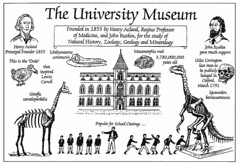University of Copenhagen has several museums (among them Medical Museion). And our university isn’t alone. Many, if not most, universities around the world have their own museums, or at least historical collections. There are in fact so many of the kind that the international museum council (ICOM) has set up a subcommittee specifically for university museums and collections (UMAC).
What defines a ‘university museum’? The only criterion for membership in UMAC seems to be that the museum shall be part of a university organisation — contentwise it can be about almost anything related to the university. So from UMAC’s point of view, a ‘university museum’ is primarily defined by ownership.
 Fair enough, but otherwise, when thinking of ‘university museums’ most people probably think in terms of content — i.e, ‘university museums’ are institutions that collect and display the history of the university. (In the same way that we think of an ‘army museum’ as one that collects and displays artefacts from the history of the armed forces, irrespective of whether it is owned by the army or by the city.) A ‘university museum’ has all kinds of stuff from good old university days, maybe even the university’s archive and image collection.
Fair enough, but otherwise, when thinking of ‘university museums’ most people probably think in terms of content — i.e, ‘university museums’ are institutions that collect and display the history of the university. (In the same way that we think of an ‘army museum’ as one that collects and displays artefacts from the history of the armed forces, irrespective of whether it is owned by the army or by the city.) A ‘university museum’ has all kinds of stuff from good old university days, maybe even the university’s archive and image collection.
However, in our internal discussions here at Medical Museion I have often thought of ‘university museum’ in a third sense, namely as a museum that functions as a university unit. And this in turn has everything to do with criteria for success.
The usual basic success criterion for museums is the popularity of their exhibitions and the number of visitors; the success criterion for university units on the other hand is the quality and originality of their research.
What distinguishes a ‘university museum’ in this third sense is that its criterion for success lies closer to that of the university than that of the ordinary museum. It’s the quality and originality of its research, curatorship and exhibition work that defines it as a ‘university museums’.
Of course, university museums want people (in large numbers) to see their exhibitions. But that aside, the basic criterion for success is whether their research and curatorial work contributes to new museological agendas or not. Better provide original solutions to small but fundamental display problems than build big and popular exhibitions.
In other words, in contrast to museums in general, which are institutions with a broad, popular appeal, ‘university museums’ are basically elitist institutions.
Museion conceptmuseum and knowledge politics
What’s a university museum?
University of Copenhagen has several museums (among them Medical Museion). And our university isn’t alone. Many, if not most, universities around the world have their own museums, or at least historical collections. There are in fact so many of the kind that the international museum council (ICOM) has set up a subcommittee specifically for university museums and collections (UMAC). […]


